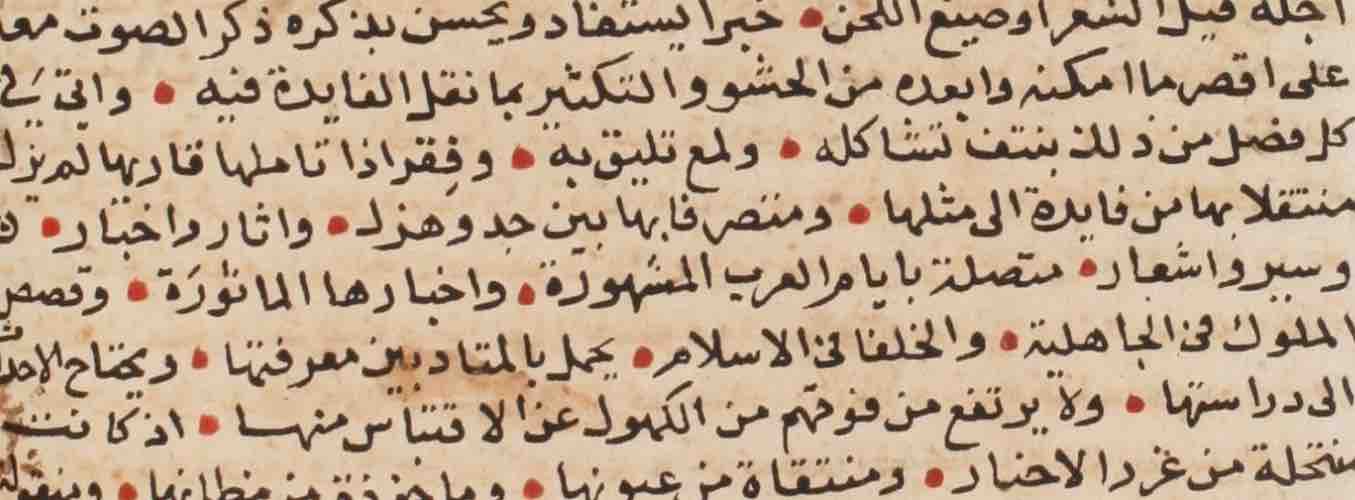Lesson
Arabic Scripts - 17th-18th centuries

Description
More examples of variation and of more casual script-types used in colophons and notes.
17th Century
Mardin, Chaldean Cathedral, CCM 333, f. 191v, 1602
Arabic colophon in an East Syriac Garshuni manuscript
Mardin, Chaldean Cathedral, CCM 333, f. 191v. Image provided by HMML.
| The tāʾ of al-kitāb (line 1) has the two distinguishing dots placed vertically rather than horizontally; see also inkataba in the same line. |
| The tāʾ marbūṭa of li-l-bīʿa (line 1) has no dots. |
| The rāʾ of al-ṭāhir (line 2) is well above the line and thus looks similar to a dāl. Contrast yarudduhu (line 5), where the two letters are clearly distinguished. |
| Kullu man (line 4) is written without a break between the words. |
| The mīm of li-makānihi is simply a small horizontal line (line 5). |
Aleppo, Syriac Orthodox Church, Archdiocese of Aleppo, SOAA 22(H), f. 21v 1618
This is a well-written, heavily vocalized manuscript. The scribe was clearly not a novice, and the book was apparently intended to be a fine copy. Note the border, the sectioned-off title in red (al-faṣl al-ṯāliṯ ʿašar), and the catchword (al-ǧalīl).
Gospel of John
Aleppo, Syriac Orthodox Church, Archdiocese of Aleppo, SOAA 22(H), f. 21v. Image provided by HMML.
| Two different kinds of final hāʾ, joined and unjoined, in line 2: nafsihi qabiltumūhu. |
| The upper arm of non-final kāf is unattached, as in kayfa (line 2) and la-kum (line 6). |
| At line end, the last letter may be written above the rest of the word (lines 2, 3, and 10). |
| The combination bāʾ-mīm in bi-mūsá (line 9). |
Jerusalem, Saint Mark's Monastery, SMMJ 270, f. 89r, 1695 July 22
The script of this copy is distinctive because of the angular ductus in which much of it is written, as well as the notable variation in line thickness. Red dots are used to divide phrases, placed in relation to the various letter forms.
As elsewhere, words may be lengthened to fill the line, as in al-madīna (line 12), which also has the dots (of yāʾ and nūn) placed imprecisely.
Gregory of Nyssa, Commentary on the Song of Songs
Jerusalem, Saint Mark's Monastery, SMMJ 270, f. 89r. Image provided by HMML.
| In lām-alif, the alif is not connected, as in qalīlan (line 13). |
| The up-and-down progression of ʿanhum (line 13). In this word, too, the nūn becomes first part of the following hāʾ. |
| The top arm of non-final kāf may either be joined or unjoined; examples of both types occur 10 lines from bottom. |
| The phrase man hiya hāḏihi (here written hādihi) l-ṣāʿida (8 lines from bottom) with hiya written entirely above the line, the final hāʾ of hādihi floating above the dāl, and the curly shape of the dotless tāʾ marbūṭa in al-ṣāʿida (8 lines from bottom). |
| The kāf forms a close unit with the following lām in bi-kulli (7 lines from bottom), as in kulluhum (5 lines from bottom). |
| The yāʾ-hāʾ combination in bi-aydīhim (5 lines from bottom). |
18th Century
Mardin, Chaldean Cathedral, CCM 25, f. 78v
The manuscript’s main text is the Syriac grammar (in Syriac) of Eliya of Nisibis, the title of which is given in East Syriac script in line 1 here.
This is a very casual script and it has a late appearance, not unlike everyday modern handwriting.
A purchase note dated 2051 AG (= 1739/40 CE)
Mardin, Chaldean Cathedral, CCM 25, f. 78v. Image provided by HMML.
| When there are two dots with certain letters, they may be written as a line (e.g., šīn in line 2, qāf in line 3). |
| The shape of the mīm in šammās (line 2, twice). |
| As seen elsewhere, the final yāʾ in ilá and fī (line 3) points backwards. |
| The dots are loosely placed in bīʿa (line 3), and the final hāʾ in the same line (actually tāʾ marbūṭa) is written simply with a rise and fall of the pen. |
| In al-muqadddasa (line 5), the dāl hardly has a bottom part, the sīn is merely a line (without the teeth), and the final hāʾ is completely closed. |
Mardin, Church of the Forty Martyrs, CFMM 395, p. 348, 1789/1790
This script is also rather casual, but uniform. The page also bears the seal of the library: maktabat dayr al-zaʿfarān.
Apocryphal stories
Mardin, Church of the Forty Martyrs, CFMM 395, p. 348. Image provided by HMML.
| The initial hāʾ is relatively large, with the right side touching the following loop at the top. There are several examples on the page, but see hāḏihi two lines from the bottom. |
| The joining line before the mīm between lām and alif in fa-lammā (line 2) comes down from above. The same is seen with the mīm in al-qamīṣ, which occurs several times on the page (e.g. two lines from bottom). |
| The shape of the final hāʾ of hāḏihi (line 5). |
| The alif of the lām-alif is written separately, as in al-malāʾika (line 8). |
| The circle of the wāw is sometimes written very tightly, as in fa-qālū (line 9) and wa-ʾaʿṭaw (line 11). |
| Contrast the overall shape of al-madīna (9 lines from bottom and 5 lines from bottom). The difference between them is a good reminder of how a single scribe might write the same word differently even on the same page. |
| In the last line, the sīn of samiʿa is merely a long horizontal line. |